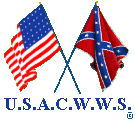
|
U. S. CIVIL WAR
PHOTOGRAPHS
|

|
MISSIONARY RIDGE
(A Continuation of the Battle for Chattanooga)
PAGE 2 OF 6 PAGES
| |
MISSIONARY RIDGE
On the morning of November 25, Grant ordered flanking attacks against the
Confederate forces, under General Bragg, on Missionary Ridge. The attack on the
Confederate left would come from General Joe Hooker, who had taken Lookout
Mountain the day before. (General H. Thomas was not to move the Army of the
Cumberland until Hooker
had reached Missionary Ridge). On the Confederate right, General William
Tecumseh Sherman would attack Confederate General Pat Cleburne's Division until Hooker
had reached Missionary Ridge). On the Confederate right, General William
Tecumseh Sherman would attack Confederate General Pat Cleburne's Division . .
Sherman began his attack, as directed, just after sunrise. His troops attacked
Cleburne's Division frontally, but without success. All night the Confederates
had worked at strengthening their position on Tunnel Hill which now formed the
Confederate right. These field works gave good protection to Cleburne's men from
enemy fire. The stubbornly fighting Confederates held their positions against
repeated attacks by superior numbers.
 221 221
Scene of Sherman's Attack - Missionary Ridge - 1860's
This fight continued until 3 p. m., and
is a notable example of the value to a greatly outnumbered defending force of
field works on a good position. Some Union troops did make a lodgment on the
slopes of Tunnel Hill in the afternoon, but a Confederate charge drove them off.
Cleburne's soldiers held the hill.
In the meantime, Hooker was in trouble --- not with the enemy, but with
Chattanooga Creek. He started for Rossville bright and early to get into
position to strike the Confederate left. Confederate General Carter Stevenson's
men, who had evacuated Lookout Mountain during the night, had burned the bridge
across Chattanooga Creek and had done all they could to obstruct the roads that
Hooker needed to march to Rossville. Hooker lost 3 hours building a bridge
across the creek and it was late afternoon before his men took their places on
Missionary Ridge.
From his post on Orchard Knob, Grant realized that Sherman's attacks had failed
to gain their objective and that Hooker had been delayed in reaching his assigned
position. To relieve some of the pressure on Sherman, Grant ordered Thomas to
move out against the Confederate center on Missionary Ridge.
The ridge that lay before the Union troops was rough and steep. It rose from 200
to 400 feet higher than the level ground at its base. Its steep slopes were
broken by ravines, strewn with boulders, and dotted with stumps, the latter
reminders of recently felled timber. The first line of Confederate breastworks was at the foot of the ridge. Some unfinished works had been built half-way up
the slope. Finally, a third line of works was built on the natural, instead of
the military, crest of the hill. Thus, Confederate fire from the crest could
not cover some of the ravine approaches.
was at the foot of the ridge. Some unfinished works had been built half-way up
the slope. Finally, a third line of works was built on the natural, instead of
the military, crest of the hill. Thus, Confederate fire from the crest could
not cover some of the ravine approaches.
Four Union divisions --- Baird, Wood, Sheridan, and R. W. Johnson, from left to
right --- started toward the ridge. The hard charging Union soldiers soon
overwhelmed the gray defenders in the rifle pits at the base of
the ridge. Scarcely halting, and generally without orders to continue, the men
in blue charged up the ridge. They followed the retreating Confederates so
closely from the rifle pits that the Confederates on the crest in many places
hesitated to fire for fear of hitting their own men. It was not long before
units of the Army of the Cumberland pierced the Confederate line in several
places and sent Bragg's veterans reeling in retreat down the east slope of the
ridge toward Chickamauga Creek. at the base of
the ridge. Scarcely halting, and generally without orders to continue, the men
in blue charged up the ridge. They followed the retreating Confederates so
closely from the rifle pits that the Confederates on the crest in many places
hesitated to fire for fear of hitting their own men. It was not long before
units of the Army of the Cumberland pierced the Confederate line in several
places and sent Bragg's veterans reeling in retreat down the east slope of the
ridge toward Chickamauga Creek.
 220 220
Headquarters Army of the Cumberland - Missionary Ridge - 1860's
Sheridan pushed forward in pursuit of the retreating army, capturing men,
artillery, and equipment. Even though the Confederate center had disintegrated,
Hardee held his position on the Confederate right until darkness, and then began
his withdrawal with Cleburne's Division covering the retreat. Bragg's army
crossed Chickamauga Creek during the night, carrying out a surprisingly
successful retreat.
During the evening of the 25th, Grant issued orders to Thomas and Sherman to
pursue Bragg. The next morning, Sherman advanced by way of Chickamauga Station,
and Thomas's troops marched on the Rossville Road toward Graysville and Ringgold.
In the vicinity of Ringgold, Cleburne's Confederates held a strong position on
Taylor's Ridge covering Bragg's retreat. Cleburne's men repulsed a Union attack,
inflicting heavy casualties , until Bragg's
army had successfully withdrawn southward, and then they followed. Union troops
then occupied Taylor's Ridge. There the pursuit stopped. , until Bragg's
army had successfully withdrawn southward, and then they followed. Union troops
then occupied Taylor's Ridge. There the pursuit stopped.
This decisive Union victory raised the siege of Chattanooga.
|
|
PAGE THREE
 >
Civil War Photos
>
Western Battlefields
>
Missionary Ridge
>
Page 2
>
3
>
4
>
5
>
6
>
Civil War Photos
>
Western Battlefields
>
Missionary Ridge
>
Page 2
>
3
>
4
>
5
>
6
Notes
|
|



